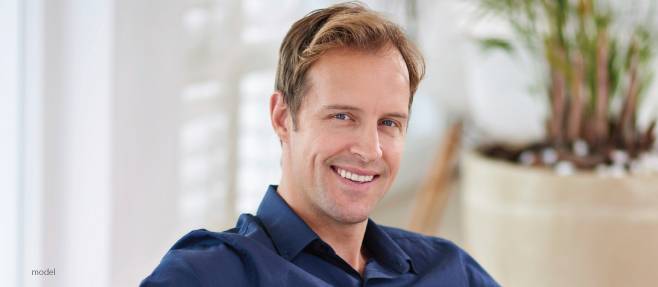Hair Transplant Recovery: Tips, Timeline, And What To Expect

If you’re considering hair transplant surgery, one of the biggest concerns you may have revolves around recovery. While a hair transplant is not considered a major surgical procedure, it does require some downtime. The hair transplant recovery experience can differ greatly from patient to patient, but we can provide an overview of the typical recovery. Here’s what most patients can expect post-procedure, along with some tips for a quick and easy recovery.
The Basics of Hair Transplant Recovery
Hair transplant is an outpatient procedure and most patients recover relatively quickly. Once you’ve healed, your results should last a lifetime. How long it takes to heal will depend on the type of surgery you had and the size of the transplanted area. In addition, genetics, general health and compliance with your doctor’s post-surgery guidelines each affect your recovery time.
While every patient’s healing journey is unique, the timeline below can give you a good idea of what to expect.
Day 1 Following Surgery:
You’ll likely be sent home after your procedure with bandages, which will be removed the following day. In addition, your doctor will give you post-operative instructions regarding hair washing, hair product usage, how to minimize pain, and when you can return to activity. Follow these instructions closely to prevent complications.
Aches or pains and minor swelling can be controlled with the pain medication prescribed by your doctor, or with over-the-counter anti-inflammatory medication.
2-7 Days Following Surgery:
You’ll might be instructed to return to the office in 1-2 days for a post-operative checkup and hair wash. Prioritize healing and rest as much as possible during the first few days. Avoid swimming, sweating, moderate to high impact activity, and exposure to the sun. Refrain from smoking or drinking alcohol, and instead, stay hydrated and eat a variety of healthy foods.
Your donor and recipient sites will begin to heal within the first few days. If your doctor gave you special healing ointment, apply this as instructed. Refrain from using your own hair products until your doctor says it’s ok.
Week 1 Following Surgery:
After the first week, most of the soreness and swelling will have dissipated. Wash your hair following the gentle washing instructions below. Continue to avoid shampoo and other hair products.
At this time, many patients feel good enough to return to light daily activity or a non-physical occupation. Refrain from high impact exercise until you’re certain all follicles have healed completely.
Week 2 Following Surgery:
As your follicles heal, they’ll begin to form pink scabs. Skin in the area may become dry and flaky. This typically lasts for no more than 2 weeks, but can take longer for those with pale, light skin.
Once your scabs have completely healed, hair follicles will go dormant and new hair will fall out. This is a normal part of the process. At approximately 4-5 months your transplanted follicles will cycle through to a growth stage and you’ll notice healthy, new hairs growing in.
If you had stitches, they will be removed around 10-14 days after your procedure. Once your hair follicles have healed, you’ll be cleared for moderate physical activity. You can begin to wash your hair with shampoo, as you normally would.
1 Month Following Surgery:
After approximately 4 weeks, you should find it’s difficult to notice a difference between the natural and transplanted areas of your scalp. As more time passes, this will only improve.
Around this time, your doctor will approve you for a return to high-impact activity and swimming. While transplanted areas may continue to shed, new hair growth is just a few short months away.
3-4 Months Following Surgery:
As new hair follicles work their way to the surface, it’s common to experience small pimples on the transplanted areas of your scalp. Holding a warm compress to the area can provide some relief if this causes tightness or discomfort.
4-9 Months Following Surgery:
New hair growth typically begins after 4 months. Approximately 60% of your new hair will become visible during this time. At first, new hairs may grow back with a thin, fine texture, but they will thicken with time.
1 Year Following Surgery:
The full results of your hair transplant will be apparent approximately 12 months after your surgery. Your newly transplanted follicles will be growing thick hair, and transplanted areas should be nearly impossible to distinguish from donor areas.
At the one-year mark, schedule a follow up appointment with your surgeon to review your results and get answers to any questions you may have. Some of the most frequently asked questions are answered below.
Why Will My Hair Fall Out After Surgery?
Many patients are shocked and disappointed when, 2-6 weeks after surgery, their newly transplanted follicles begin to shed hair. This is normal and expected and is merely part of the healing process.
Hair follicles go dormant as part of the natural growth cycle, but will return to a growth stage again, 4-8 weeks later. Once hair begins to grow back, you can expect growth of approximately one-half inch per month.
Is Hair Transplant Recovery Painful?
While you are healing it’s normal to experience redness, tenderness, itchiness, numbness and minor pain. These symptoms last, on average, for just the first few weeks.
During this time, you can use over the counter anti-inflammatories, such as ibuprofen, naproxen or aspirin, to relieve these symptoms. In addition, it’s important to closely follow your doctor’s post-operative instructions.
Will I Need a Follow Up Procedure?
After your incisions have completely healed, it’s possible you’ll need a surgical touch-up to create more natural looking results.
This may involve filling in the hairline using a combination of mini-grafts, micro-grafts or slit grafts for a more blended look. If you’ve had a flap procedure, you may be left with a small bump called a dog-ear, which can be surgically removed once you’ve healed.
Expect that you’ll need a touch-up procedure to fully realize the most natural-looking results. This second procedure will be less extensive than the first. As you heal, your surgeon can help you predict what this follow up will be like.
Gentle Hair Washing for Weeks 1-2
Until your stitches have been removed and incisions and hair follicles have begun to scab over and heal, use the following gentle hair washing method once daily.
- Fill a clean bowl with warm (not hot) water
- Add a small drop of tea tree shampoo and mix until water is frothy
- Use a cup to carefully pour the solution over your head
- In the transplanted areas, gently pat on the graphs
- Wash suture lines with a light, circular motion
- Ensure all areas are completely rinsed using clean, lukewarm water
- Let hair air-dry or pat gently with a clean, dry towel
Disclaimer: The contents of the Westlake Dermatology website, including text, graphics, and images, are for informational purposes only and are not intended to substitute for direct medical advice from your physician or other qualified professional.
